If you’ve ever found a soup can in the corner of your pantry months past the expiration date, or ended up buying pasta sauce without knowing that you already had a jar buried in the back, you’re not alone. Your pantry is a great all-purpose storage unit, but a messy one can throw off your kitchen groove. Organizing your pantry is a matter of developing a consistent system that allows you to optimize space, easily access the items you use the most and know exactly when things are nearing their toss-out date. Read on to learn our pantry shelving ideas and other (small) pantry organization tips.
1. Develop a System That Addresses Your Needs
Organizing your pantry begins with assessing your needs. During your next kitchen deep clean, take everything out of your pantry and throw away any expired foods. Ask yourself:
- What are the most popular snacks, ingredients and spices in my pantry? (Which ones do I go through frequently?)
- How often do I go grocery shopping, and what items do I buy regularly?
- What items are about to expire — and how long before they do?
- Which ingredients in my pantry do I use only during certain seasons?
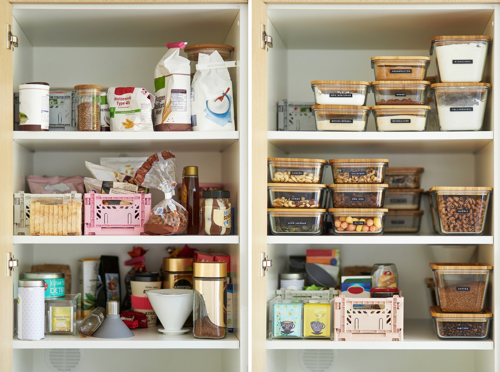
These questions alone can help you start to create a system that works with (and not against) your kitchen habits.
For example, conventional wisdom states that “like” should go with “like” in your pantry (i.e., you should keep things like spices together), but this may not be the best option for you.
Instead, consider keeping the spices you use on a daily basis on a shelf close at hand, and the others in a corner tray. Think about who in your household eats what — if you have small kids who like the granola bars and gummies, keep them lower to the ground so they don’t have to climb on top of a chair or accidentally knock things over to reach them. And if you have foods that are about to expire, store them front and center so you remember to use them up.
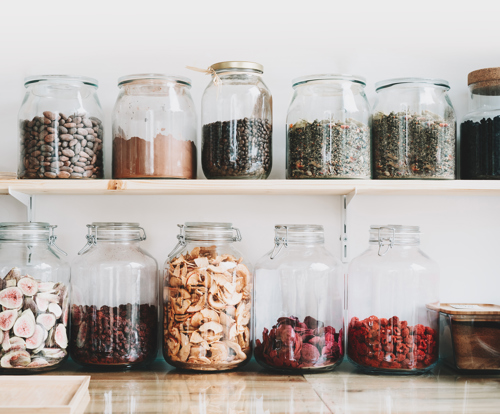
2. Decant Into Food Storage Containers
Decanting isn’t just an aesthetic choice — it also streamlines your storage efforts and helps you make more efficient use of your space. (Not to mention that it can prevent an infestation of flour beetles!) So instead of keeping family-sized or bulk items in their bags, pour them out into rigid, airtight containers. (Even better if they’re stackable, too.) Square or rectangular vessels are best for cereals, nuts and other “pourable” dry goods, while wide-mouth glass jars are ideal for flour, rice, oats and other grains that need to be scooped. Though clear containers can help you spot their contents more easily, adding labels doesn’t hurt.
| Tip: Reuse old glass jars instead of buying new ones to minimize waste. If you’re having trouble removing sticky labels from your jars, try soaking them for about 20 minutes in hot water mixed with a tablespoon each of dish soap and distilled vinegar. You can also use a hairdryer to heat up the adhesive and make peeling off the stickers a breeze. |
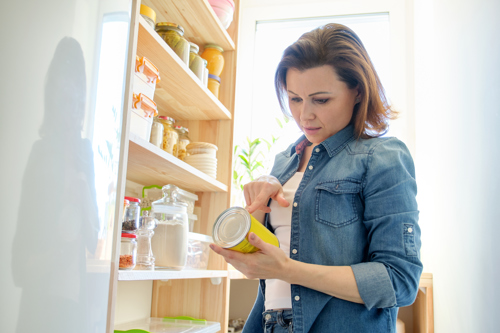
3. Know Your Dates
FIFO — first in, first out — is a professional kitchen term that you should use in your house, too. The idea is simple enough: store items with earlier expiration dates in front of the rest, and always grab from left to right so you avoid buying an item before you’ve used it up. Though this shouldn’t be a problem with the snacks you eat every day, it’s wise to check the dates of your extra cartons of chicken broth or cans of coconut milk every month to stay on top of your dates. (If you have any goods that haven’t expired but you won’t have time to eat, consider adding them to a care package or donating them to your local shelter.) Be sure to add dates to any items you decant (you can write the month, day and year on a strip of blue tape).
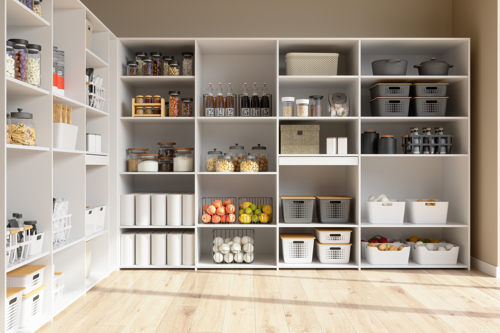
4. Organize for Visibility and Accessibility
The two principles of good pantry organization are visibility and accessibility. Stacking soup cans on top of one another in deep rows will make grabbing them a pain, and can block you from a quick assessment of what you have and what you need come grocery day. Even if your pantry doesn’t come with an abundance of roomy shelves, you can easily hack your way to more space and better reach with affordable tiered stacking options, lazy Susans and multi-purpose bins (to keep loose snack bags orderly). Investing in storage that can hang from your doorway can give you more options, too.
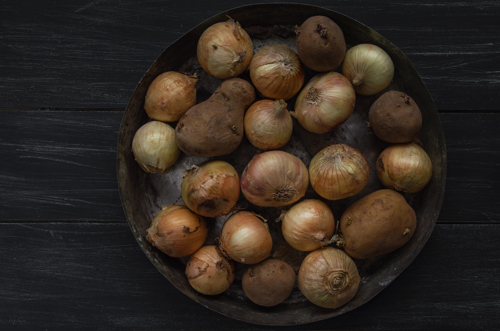
5. Learn What Foods Are “Bad” Neighbors
Some fruits and vegetables emit a gas called ethylene when they’re ripening — and when you store them next to each other, they can speed up the spoiling process. Apples, for instance, produce a lot of ethylene, so keep them away from other produce in your pantry. Onions, which you should store in a well-ventilated space, are best kept afar from potatoes (onion gas can make potatoes sprout more quickly).









